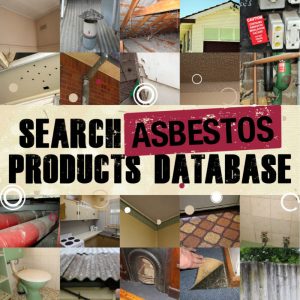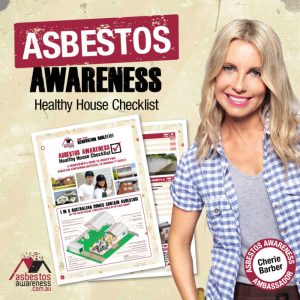
Asbestos Management – be aware of where asbestos might be found before you start work.
Free Household Asbestos Testing Kits
A limited number of Household Asbestos Testing Kits are now available to help residents identify asbestos-containing materials in their homes. These kits are designed to assist with the safe management or removal of asbestos. The free kits are available to residents within our region (households only, not for commercial/industrial use).
Please complete registration here (nirw.org.au/asbestos-test-kit-request). NIRW will allocate you a free test kit and send it to your local Council for you to collect.
If you miss out, Asbestos testing can be organised through any NATA-accredited laboratory. Find a NATA-accredited laboratory today.
Asbestos Management
Asbestos lurks in more places than you’d think
It is easy to forget that asbestos is still present in millions of Australian homes, but it’s a fact that if a house was built or renovated before 1990, there’s a good chance it has some asbestos. Even though it has been banned in Australia since 2003, at the height of its use asbestos was in over 3,000 products and many of these products are still contained in our homes and workplaces.
DIY home renovators and tradespeople working in homes are most at risk of being exposed to the deadly material. Call a professional to check, remove and dispose of asbestos safely.
For more information visit Safework NSW or Call 1800 Asbestos (1800 272 378).
Why is asbestos a problem to human health?
Asbestos is a known carcinogen and inhaling asbestos fibres can cause a number of life-threatening diseases including pleural disease, asbestosis, mesothelioma and lung cancer. Asbestos-related diseases cause approximately 4,000 deaths a year.
Asbestos can be easily disturbed when doing renovations, home improvements and maintenance. Asbestos materials are still commonly found in bathrooms, laundries, and kitchens as well as behind tiles and under flooring.
Don’t be complacent about the dangers of harmful asbestos fibres and to be aware of where asbestos can be found.
For more information visit Safework NSW or Call 1800 Asbestos (1800 272 378).
Before you start your work around the home, be aware. Protecting yourself and your family can be as simple as getting an asbestos check from a licensed asbestos assessor who can advise where asbestos might be in the home, and how to manage the risk safely.
Just like plumbing and electrical work, asbestos removal – or jobs around the home that might uncover asbestos – are jobs best left to the experts.
Be aware: Asbestos lurks in more places than you’d think.
Where can you find Asbestos in the home?
Here are some examples of the various locations that asbestos was used in homes between the 1940’s – 1990.
Outside the home
- Roof sheeting and capping
- Gutters, gables and eaves
- Water pipes and flues
- Cladding for walls, including imitation brick cladding
- Fencing
- Carports, garages, outhouses, garden sheds and dog kennels
Inside the home
- Wall sheeting, particularly in wet areas such as the kitchen, bathroom, toilet and laundry.
- Ceiling sheeting
- Plaster patching compounds and textured paint
- Electrical switchboards
- Vinyl floor tiles and felt backing for vinyl and linoleum flooring
- Insulation in domestic heaters and stoves
Asbestos Facts
- An estimated 4,000 Australians die annually from asbestos-related disease. This is more than triple the annual road toll.
- Approximately 700 people die annually form the aggressive cancer mesothelioma caused by exposure to asbestos.
- A house built or renovated before 1990 has a good chance of containing asbestos.
- Asbestos was used in over 3,000 products prior to 1990 – a great many of these were is residential construction and fit out.
- Asbestos was completely banned in Australia in 2003 (31 December 2003).
- Over 6,000 tonnes of asbestos is illegally dumped per year.
- The World Health Organization says there is no known safe minimum level of exposure.
- You cannot see asbestos fibres – they are invisible to the naked eye.
Mesothelioma Cancer
Mesothelioma is a form of cancer that is caused by inhaled asbestos fibres and forms in the lining of the lungs, abdomen or heart. Symptoms can include shortness of breath, chest pain and fluid around the lungs. Sadly, the life expectancy for most mesothelioma patients is approximately 12 months after diagnosis.
The Australian Mesothelioma Registry (AMR) is a database that contains information to better understand asbestos exposure and mesothelioma from real cases. The AMR develop community education and awareness strategies, assist in policy development and assist researchers.

Further Information
Visit www.asbestossafety.gov.au or www.asbestosawareness.com.au for more information.
You can also search the Asbestos Products Database for information on products that contain asbestos. https://asbestos.nsw.gov.au/asbestos-finder
Tradies
Make sure you know what to do when working with asbestos – Plumbers, Tilers, Carpenters, Builders and Electricians. Avoid workplace hazards. PPE cannot guarantee your health or safety, but it will help reduce your risk of exposure. It must be selected, worn and removed correctly to be effective. You also need to follow safe work practices to prevent asbestos contaminating everything around you.
For more information visit Safework NSW or Call 1800 Asbestos (1800 272 378).

DIY Home Renovators
Asbestos lurks in more places than you’d think. Before you start, be aware. KNOW the health risks of asbestos exposure. BE AWARE of where asbestos might be found before you start work. CALL a professional to check, remove and dispose of it safely. Get your free Healthy House Checklist to assist you.
